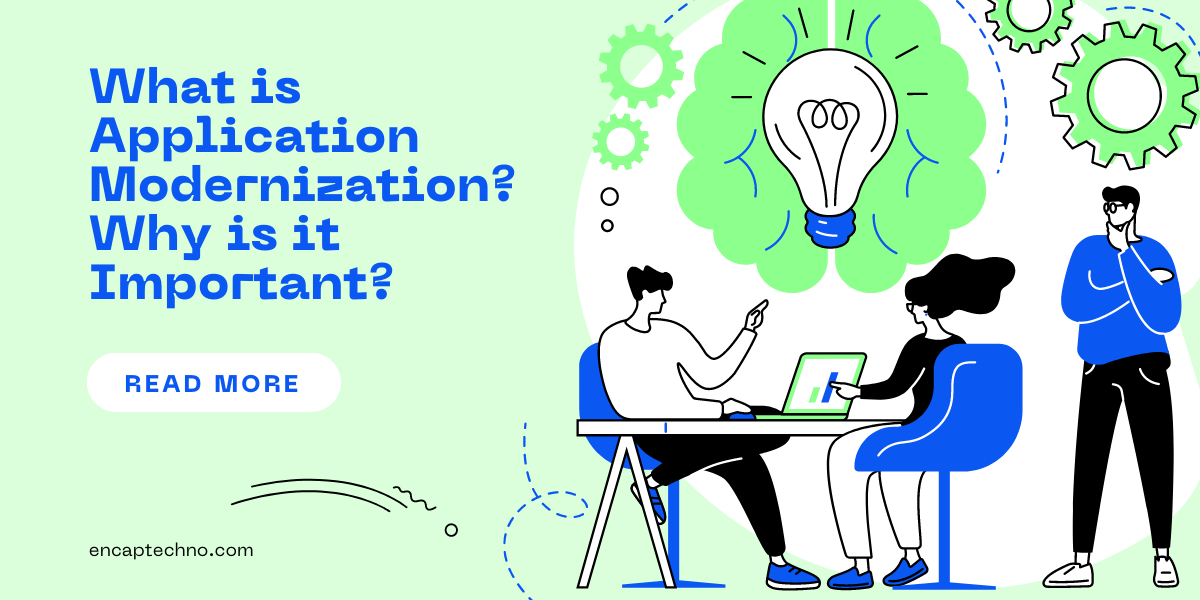What is Application Modernization? Why is it Important?

The common business goals include gaining efficiencies, reducing costs, and making the most out of all existing investments. Application modernization is something that helps in achieving all of that. It is a process that includes a multi-dimensional approach of adopting and using new technology for delivering portfolio, application, and infrastructure value quickly. It also helps in positioning an organization to scale at an optional price.
Application modernization services lead to optimizing your applications. After an organization is successful in doing that, it becomes possible to operate in the new and modernized model without causing any disruption in simplifying a business operation, architecture, and overall engineering practices.
Application modernization is like taking your application environment in the form that it is in today and transforming it into something that is elastic, agile, and highly available. While doing this, you can change your business into a modern enterprise. For optimizing cloud adoption and migration, one must first assess and evaluate an enterprise and test its readiness.
After a person is successful in assessing an organization’s readiness, it becomes possible to select either one or two applications, modernize these applications for maintaining, extending, deploying, and managing them, and establish a foundation for modernization at scale. This is an iterative approach to application modernization that is divided into assessing, modernizing, and managing.
Table of Contents
Modernizing Applications Effectively

When it comes to application modernization trends, it mostly comes to two specific patterns known as refactoring and re-platforming. Below, we will explore both of them in detail including the real-world success stories that help in understanding the real meaning of refactoring and re-platforming an application:
- Refactor: The process of refactoring can be linked to rearchitecting an application into a comparatively modular design that is commonly referred to as microservices or modular architecture. The entire process of refactoring can provide high rewards such as adopting modular architectures with server-less technologies helps in improving agility by lowering the time and resources needed to build, deploy, scale, and maintain applications.
Application modernization services also reduce the overall cost of ownership by improving operational efficiency and resource utilization. With the modular services, there are more moving parts for managing which is why it is recommended that one should adopt serverless technologies as much as possible for eliminating the operational overhead.
Most customers focus on refactoring by automating software delivery wrapping the applications with the APIs and decoupling application components. The new applications can be created from the ground up with a modular design and technologies for achieving the benefits. All business-critical applications are considered prime candidates for refactoring.
Let’s take data warehouses as an example. They connect organizations to the customers as mobile applications generate new revenue and competitive differentiation and back-end services power the organization with an added efficiency. When the applications are not quick enough, scalable, have poor resource utilization, and need cost and operational overhead for maintenance, refactoring is the best way forward.
The process of refactoring to microservices also lends itself to the formation of small and independent teams that can take ownership of each service easily. This is an organizational change that fosters an environment of innovation for the development teams while giving them the authority to make changes that can lower organizational risks as a whole.
- Replatform: The process of replatforming involves moving from services that you have been managing yourself to fully managed cloud computing services. This is done without changing the core architecture of an application. You will mostly choose the option for the applications that must be reshaped to match the overall cloud strategy or for taking better advantage of the native capabilities of the cloud provider.
The cloud provider should be able to offer assistance throughout the whole process. More so, AWS provides managed services that allow you to reduce operational overhead without rewriting any code. If you are managing the messaging broker today, you can simply replace it with the fully managed Amazon MQ service without rewriting or even paying the third-party software license.
On the other hand, if you are migrating a Windows-based application that needs file storage, it is also possible to use the fully managed Amazon FSx for the Windows File Server. For reducing the amount of time that is spent on managing Kubernetes clusters, one can choose to move to a managed Kubernetes service such as Amazon EKS. Once you are ready to move to an existing application straight to containers, it is also possible to streamline the process with AWS App2Container (A2C).
The A2C is a command-line tool used for modernizing NET and Java applications into containerized applications. It helps in analyzing and building an inventory of all applications running in virtual machines, on-premises, or in the cloud and packages for perfect application artifacts and identified dependencies into containers.
Benefits of Application Modernization

The process of modernizing a business application is an important part of doing a business. You can choose how you want to migrate the application with AWS and at which pace while leveraging the reliable infrastructure of an industry with the deepest set of services.
While deploying the application modernization services, the enterprises can also reduce any paycheck periods to just 6 months along with the total cost of ownership. With the use of AWS, your cloud migration and application modernization plans are based on business needs and not agreements or licensing.
For example, with the use of AWS, you can lift and shift the applications, refactor them and completely re-platform them as well. You can make the choice that suits your organization the best. Modernizing an application with AWS can help in reducing costs, gaining efficiencies, and making the most out of existing investments.
The three important benefits of application modernization are mentioned below. They include:
1. Driving Growth

All enterprises that are looking to modernize technology can save money with the use of AWS while building new applications and retiring from legacy solutions. When an organization plans cloud migration to AWS, it becomes very easy to reduce the cost of ownership.
Many resources are freed and you can focus on the core mission of your enterprise which is to manage services and buildings. In addition, the hyper-scale breadth of services and automation levels in AWS also helps in achieving incremental savings and significant cost optimization.
When you deploy enterprise solutions in AWS, you can also retire expensive legacy infrastructure, reduce costs, gain agility with automation and free up many resources that drive innovation as opposed to focusing more on undifferentiated work.
2. Accelerating Migration to Cloud
The business applications are like an engine that helps the company to run and allows you to make decisions, gain insights, and also process valuable data. As an important part of the digital transformation journey, you can reach new levels of operational efficiency, increased scalability, and improved performance when you migrate to AWS.
Owing to this, migration to the cloud requires a provider with experience in retiring datacentres, the right program, and enterprise technologies ready to move applications to the cloud. AWS offers the Migration Acceleration Program and services for migrating databases, servers, and data and giving a person the right tools to achieve cloud migration.
3. Maximizing Investment Value
As the cloud journey goes ahead, an organization wants to maximize the value of hardware, software, and business applications. An important part of a digital strategy requires a person to run hybrid environments and maximize the use of existing solutions that are built on Microsoft Windows Server, Oracle, IBM, etc.
With the use of AWS, it becomes possible to use innovative technology for running all systems of a platform that allows integration with legacy applications and cloud-native solutions. This also gives an ability to run the value enterprise applications in the cloud and empowers an organization to get the best possible return from assets, legacy, and everything in between.
- Increases Productivity: In this digital era, almost everyone wants to upgrade themselves with the latest technology. However, if an organization is using an out of date software or technology, the employee satisfaction level goes down and that impacts the productivity as well.
In addition, if the developers and administrative staff can access modern technology, it becomes easy to be more productive. When one works on the same thing repeatedly, things become boring.
Anytime when the company grows, they hire new staff, and educating every new resource on how to run a legacy IT system is costly and time-consuming. However, application modernization services, tedious tasks, and repetitive processes can be automated because of which it is easy to educate new employees.
Business Outcomes After Application Modernization
The process of application modernization requires a holistic approach of assessing, modernizing, and managing to bind the different dimensions that provide completeness at an accelerated pace. The common framework that is recommended by AWS envisions modernization across five important technical domains including automation, developer workflows, self-service data, architecture evolution, and organizational value.
The framework used in AWS professional services and AWS partner engagements includes a knowledge base with solutions, playbooks, self-service technical patterns, and templates. A successful modernization project also produces the following business outcomes.
1. Business Agility
The business effectiveness translates the business into requirements. With application modernization, you can tell how responsive the delivery organization is to business requests and how much control the business has in releasing functionality into product requirements.
2. Organizational Agility
The delivery process includes agile methodologies and DevOps ceremonies. It supports clear role assignments and overall collaboration and communication all across an organization.
3. Engineering Effectiveness
Application modernization services improve quality assurance, testing, continuous integration, continuous delivery application design, configuration management, and source code management. Achieving all business outcomes requires a holistic approach and a modernization process that must be based on strategic dimensions.
Conclusion
At the present time, most applications are built with a combination of modular architecture, agile development processes, and serverless models that enable organizations to innovate much faster, accelerate marketing time and lower the total cost of ownership.
The modern applications cover an expanding range of use cases including web and mobile apps, back-end services, data processing techniques, and machine learning. These applications take advantage of the latest technologies and help in quick development and deployment.
Encaptechno has gained prominence in offering the best amazing web services. If you want to know more about the application modernization services then please get in touch with Encaptechno, today.

No comments